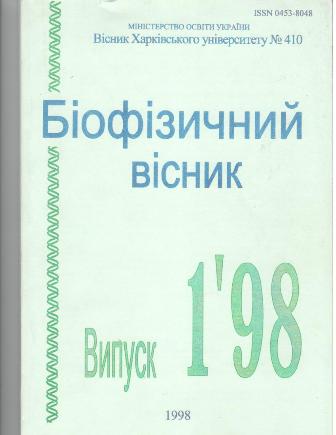THERMODYNAMICS OF HELIX-TO-COIL TRANSITION IN DUPLEX AND TRIPLEX COMPLEXES OF OLIGOADENILATE WITH OLIGOTHYMIDYLATE. INFLUENCE OF COVALENTLY ATTACHED DYE
Abstract
Helix-to-coil transitions in oligonucleotide (dA)15 complexes with (dT)10 and (dT)12 as well as with intercalating phenazine dye attached covalently, have been thermodynamically analyzed. At molar strand ratios 1:1 and 1:2 and μ = 0.1 and 1 thermodynamic transition parameters ΔH, ΔS and ΔG and equilibrium constants were calculated for duplex and triplex structures by using the "two state" model and the modified "staggering zipper" model. Declination of experimental dependencies from the "two state" model was found for duplexes containing phenaztne attached. This effect is interpreted as a result of the effect of the impurity triplex state. It was stated by the help of model "staggering zipper" calculations that terminal group of the complexes are in a partially disordered state the degree of which increases with temperature. It is shown that strengthening of both complex types by the dye attached may be taken into account by multiplication of the complex binding constant by the attachment constant of the dye in the complementary structure.
Downloads
References
2. Frank-Kamenetskii M.D., Mirkin S.M.// Annu. Rev. Biochem. 1997. V.64. P.65-95
3. Pilch D.S., Levenson C, Shafer R.H.// Proc. Natl. Acad. Sei. USA 1990. V.87. P. 1942-1946
4. Hopkins H.P., Hamilton D.D., Wilson W.D., Zon G.// J. Phys. Chem. 1993. V.97. P.6555-6563
5. Kibler-Herzog L., Kell В., Zon G., Shinozuka K., Mizan Sh., Wilson W.D. // Nucl. Acids Res. 1990. V. 18. P. 3545
6. Pilch D., Brousseau R., Shafer RH.// Nucl. Acids Res. 1990. V. 18. P. 5743-5750
7. Goodchild J. //Bioconjugate Chem. 1990. V.1. P. 165-187
8. Asseline U., Delarue M., Lancelot G., Toulme F., Thuong N.T., Montenay-Garestier T., Helene С. //Proc. Natl. Acad. Sci. USA 1984. V.81. P.3297-3301
9. Lokhov S.G., Podyminogin M.A., Sergeev D.S., Silnikov V.N., Kutyavin I.V.Shishkin G.V., Zarytova V.P. // Biocojugate Chem. 1992. V3. P. 414-419 : -
10. Зозуля B.M., Благой Ю.П., Дубей І.Я., Федоряк О.Д., Щербакова A.C., Федоряк Д.М.// Биополимеры и клетка. 1998. Т. 14. С. 1 -8
11. Applequist J. // J. Phys. Chem. 1963. V.38. P. 934
12. Applequist J., Damle V. // J. Am. Chem. Soc. 1965. V.87. P. 1450
13. Zimm B.H. // J. Phys. Chem. 1960. V.33. P. 1349
14. Riley M., Maling В., Chamberlin M.// J. Mol. Biol. 1966. V. 20. P. 359-389
15. Klump H.H.// Can. J. Chem. 1988. V. 66. P. 804-811
16. Hopkins H.P., Hamilton D.D., Wilson W.D., Campbell J., Fumero J.// J. Chem. Thermodynamics. 1993. V.25. P.111-126
17. Zozulya V., Blagoi Yu., Lober G., Voloshin I.,Winter S., Makitruk V., Shalamay A.// Biophysical. Chem. 1997. V. 65. P. 55-63
18. Krakauer H., Sturtevant J.M. // Biopolymers. 1968. V.6. P. 491
19. Martin F.H., Uhlenbeck O.C., Doty P. // J. Mol, Biol. 1971. V. 57. P. 201
Authors who publish with this journal agree to the following terms:
- Authors retain copyright and grant the journal right of first publication with the work simultaneously licensed under a Creative Commons Attribution License that allows others to share the work with an acknowledgement of the work's authorship and initial publication in this journal.
- Authors are able to enter into separate, additional contractual arrangements for the non-exclusive distribution of the journal's published version of the work (e.g., post it to an institutional repository or publish it in a book), with an acknowledgement of its initial publication in this journal.
- Authors are permitted and encouraged to post their work online (e.g., in institutional repositories or on their website) prior to and during the submission process, as it can lead to productive exchanges, as well as earlier and greater citation of published work (See The Effect of Open Access).





